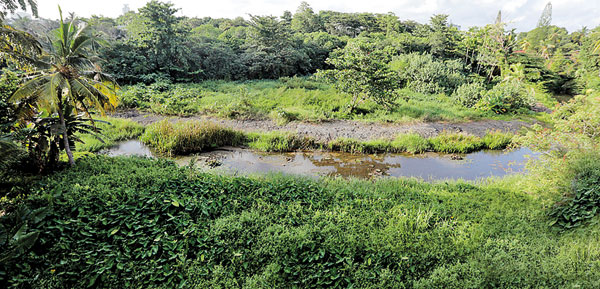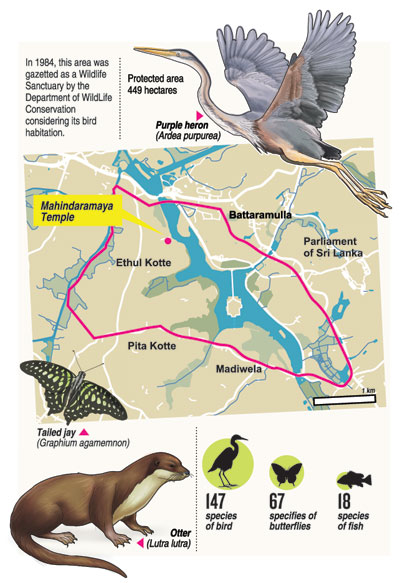News
Controversy surrounds urban sanctuary development: Wetlands and biodiversity at stake
View(s):By Tharushi Weerasinghe
Last year, vigilant residents near the sanctuary noticed construction machinery within the protected grounds. In just a span of twelve months, the verdant tree line that once graced Alakeshwara Road in Kotte succumbed to development, transforming the scenery profoundly. The rapid alterations have triggered inquiries about the true motives behind the construction and the sanctuary’s impending fate.
Authorities initially claimed that construction approvals were granted for a canal to protect against encroachment and bolster flood defenses. But investigations by the Sunday Times have revealed a different story – the cut canal seems to be part of a plan to create a private biodiversity park.

A canal has been cut around the sanctuary, effectively cutting off all access to it that people in the area enjoyed before.
The sanctuary, visible and accessible from various points, stands before the Ethul Kotte Mahindaramaya Temple on Nippon Avenue. The temple’s Chief Prelate, Meegahathanne Chandrasiri, is leading the construction. He also runs the Lanka Nippon Educational and Cultural Centre adjacent to the temple, an organization he claims is funded by Japan. The temple’s Chief Prelate has confirmed that the construction is for a biodiversity park which he insists has been in planning for two decades. The Sunday Times reached out to the Japanese Embassy for confirmation but received no response.
The Kotte Sanctuary is inclusive of two state-run biodiversity parks which include the Beddagana Wetland Park and the Diyasaru Park, within 2 km of it. The resistance he faces, he claims, comes from acquisitive land owners that want to encroach on state lands for their personal benefit.
The land which comes under the Wildlife Conservation Department (WCD)’s Fauna and Flora Protection Ordinance is owned by the Urban Development Authority (UDA).
“A mistake I’ve made is not obtaining WCD clearance but the UDA has given me this land to construct this on the temple’s own dime,” he said when the Sunday Times requested the Venerable for an official interview, with an opportunity to study the alleged 20-year-old masterplan. The Venerable refused claiming official statement could not be made to the media without the permission from his donors.
Presently a canal has been cut around the sanctuary, effectively cutting off all access to it that people in the area enjoyed before. It is now only accessible from the temple’s side.

This drain was cut by the Sri Lanka Land Reclamation and Development Corporation at the request of the UDA.
“We cleared an acquisition border upon the UDA’s request to stop encroachment from private land owners,” noted a management-level official from the SLLRDC that wished to remain anonymous.
They noted that the canal that was cut should’ve been cut on the acquisition border but this would have resulted in houses over the border having to be removed. This canal also had the Wildlife Conservation Department’s approval. The WCD approved the UDA’s request for a canal on the basis of stopping encroachment and improving flood control.
Conditions for the canal were that it had to be cleared and that the slopes be built adequately for natural flood control to take place.
“One of the primary conditions was that the water levels of the marsh had to be maintained so that parts of it don’t become too dry and affect its holding capacity, which in turn affects how effectively it controls floods,” noted Manjula Amararathna Deputy Director,WCD.
The Sunday Times inspected areas across the water that had been cut through Alakeshwara Road and found that the marsh had already receded by a significant amount. “The water used to reach just outside our fence before but now that area is dry throughout the year,” one resident told the Sunday Times. The WCD got involved in the controversy surrounding the Sanctuary when residents complained of the 12-hour-long construction activities that were felling trees during the height of the country’s fuel crisis.
Despite the canal being done, construction vehicles and workers have been spotted on site by residents as recently as two weeks ago. Equipment was still on the sanctuary when the Sunday Times visited the area.
The proposal for a biodiversity park only reached the WCD office two months ago, after months of unspecified work being carried out on the ecological site.
Several WCD flight teams have visited the area every time complaints are made but work halts for a few days before commencing again.
Deputy Director Amararathna noted that any WCD approvals should have been obtained prior to any commencement of projects on the protected site noting that even work on the canal was initially stalled and then granted permission under their conditions. “But the UDA has given the monk permission to build on their land,” he noted echoing what the Venerable told the Sunday Times.
Director General of the UDA, Prasad Ranaweera vehemently denies this. “All the work done has been started without the necessary approvals from us which is why we have filed a police complaint to take this matter to court,” he told the Sunday Times, adding that this came following multiple warnings that the venerable had allegedly ignored.
The UDA had received a proposal on the project but no approvals would be given until the necessary environmental impact recommendations were obtained he assured.
Nonetheless, UDA and SLLRDC equipment was seen on site by residents just a few weeks ago and activity inside the woodland which has already cost the sanctuary many of its trees has been consistent.
Environmentalist Sajeewa Chamikara who has been highlighting this issue since its inception told the Sunday Times that the neglect and misappropriation of protected state lands by the WCD and UDA respectively was in violation of multiple sections in the Fauna and Flora Protection Ordinance and the Penal Code.
The activity itself, according to Chamikara, is an offense that permits a warrantless arrest. The work is also in violation of the National Environmental Act of 1980 which states that constructions on wetlands exceeding 4 hectares cannot be done without an Environment Impact Assessment.
He also pointed out that Colombo was recognized as a Ramsar Wetland City which makes any anti-conservatory actions a violation of Sri Lanka’s international commitments to protect wetlands.
The Central Environment Authority told the Sunday Times that this project was happening outside of their purview of prescribed activities. “Since the area falls under the Department of Wildlife Conservation they can as the approving organization ask us for recommendations, which hasn’t happened,” noted an officer from the Natural Resource Management division.
Complaints on destruction that citizens want to report can be made on the 1981 hotline nonetheless, they added.
The best way to say that you found the home of your dreams is by finding it on Hitad.lk. We have listings for apartments for sale or rent in Sri Lanka, no matter what locale you're looking for! Whether you live in Colombo, Galle, Kandy, Matara, Jaffna and more - we've got them all!

